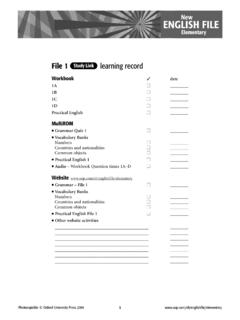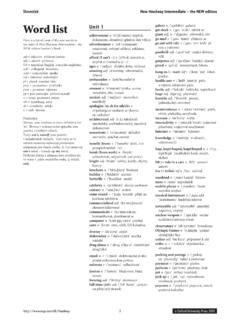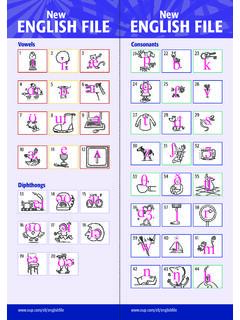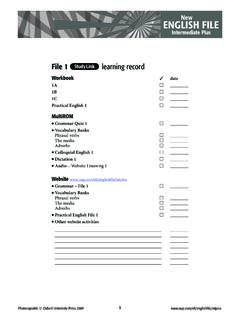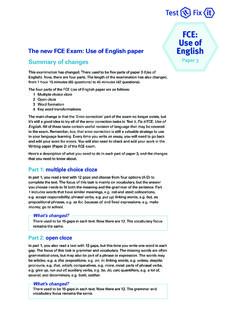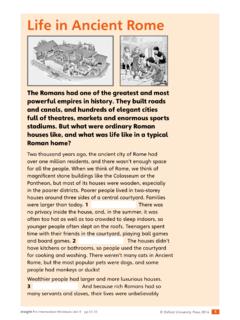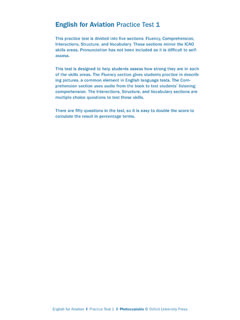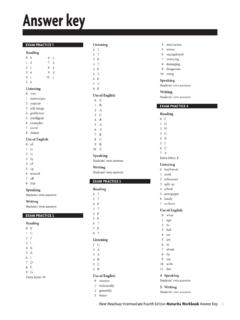Transcription of Oxford English Grammar Course - Oxford University Press
1 Oxford English Grammar Course advanced Michael Swan and Catherine Walter 2013 Oxford English Grammar Course advanced -LEVEL TEACHER S GUIDEINTRODUCTION TO THE BOOKThe purpose of the Oxford English Grammar CourseOEGC is intended to help those students who want or need to make their English more grammatically correct. Our aim is not necessarily to encourage teachers and students to do more Grammar there are many other things that have to be fitted into a language programme. Our purpose is simply to make this important component of a Course as effective as possible, so that students can learn the Grammar that they need successfully and without wasting time. The explanations and exercises in a book of this kind will not of Course guarantee faultless speech or writing by learners nothing will, and in any case few foreign-language learners need to aim at a native-speaker level of accuracy.
2 But such work can help to make students more aware of the correct formation and use of key structures, and thus usefully reduce the number of errors in their the bookLike any Grammar practice book, OEGC advanced can be used in various ways. Most teachers will probably wish to use it selectively, working on broad topics ( modal verbs) or particular points ( the expression of certainty) that classes or individuals need to learn or revise. Some language specialists, however, may find it useful to work through the whole book. A good deal of the work can be done for homework, thus freeing up valuable class time for other activities. The book is also suitable for will have their own ways of using this kind of material in class, and we would not wish to suggest any kind of step-by-step procedure. We do, however, suggest that, where possible, teachers translate the Grammar explanations into the students mother tongue.
3 (There is no basis in theory or research for the old dogma that the mother tongue should be avoided at all costs in language teaching. There are times when it is extremely helpful, and Grammar explanation is one of them.) We also suggest that, as far as possible, teachers avoid a turn-taking oral approach to exercises ( You do number 1, you do number 2, ..). Students learn what they do, and if what they do is mostly listening to other students, that is what they will learn scarcely a high-priority skill! The more they can do Grammar exercises through group work, or other activity types which enable them all to work at the same time, the more practice each individual will get. The answer key can be used by students to check whether they have understood the material correctly. Students being what they are, some will no doubt cheat by using the key to do the exercises; they will learn very little English by doing so.
4 Content and levelOEGC advanced spans quite a wide range. It includes a good deal of revision work on points which will have been studied earlier, but which may still cause problems to some learners. At the other end of the scale, it covers some topics which may only be valuable for English specialists who need a high-level command of the structures of the language, particularly those of formal written English . For such students, additional notes on matters of detail (printed on a grey background) are provided where this may be this level, Grammar and skills come closer together, as the aspects of Grammar that are involved in the structuring of written and spoken texts assume increasing importance. Oxford English Grammar Course advanced Michael Swan and Catherine Walter 2013 OEGC advanced has a separate 50-page section ( Part 2 ) which focuses particularly on Grammar beyond the are often illustrated in real-life contexts such as short texts, quotations, advertisements or cartoons.
5 These are generally intended as undemanding reading matter for students, which will help to introduce the structures and perhaps fix them in students minds. They are not necessarily meant as exercise material. They can of Course be exploited in this way if teachers wish, but we think there is an important place in language work for no-hassle reading. Cartoons can be problematic, especially with students from backgrounds with different approaches to humour from European cultures: the jokes may sometimes need explanation by the teacher, and may occasionally simply not get across at all. However, cartoon captions can also constitute very direct and memorable illustrations of one or other point of Grammar , and we feel they are well worth including for this reason. Pronunciation for Grammar in the e-bookGrammar and pronunciation have a good deal to do with each other. For many students, the main problem with English pronunciation is not productive but receptive: they can be understood more or less well, but they may have great difficulty themselves in understanding natural speech.
6 This is largely due to the character of English stress and rhythm: unstressed syllables are pronounced quickly and unclearly, and frequently with a reduced pronunciation. These syllables can be hard for many students to perceive, especially if their languages do not have a similar phonetic structure. These unstressed syllables are mostly grammatical elements: auxiliary verbs, articles, prepositions and conjunctions. Grammatical endings, too, can be hard for non-native hearers to catch: the difference between, for example, stop, stops and stopped is not easy to perceive for a student whose language does not have final consonant Pronunciation for Grammar component of the e-book provides a large number of exercises linked to the various grammatical topics dealt with in the Oxford English Grammar Course advanced . Their purpose is to sensitise students to these unstressed grammatical elements, so that they learn to perceive them more easily (as well as practising their correct production).
7 These exercises also help students to distinguish the intonation of questions and statements, and to perceive and produce typical English patterns of stress and rhythm. Learners of English today are likely to use the language in a variety of international contexts. We have felt it useful, therefore, to include some recordings which introduce students not only to different native-speaker accents (standard British, Scottish and US American), but also to examples of non-native (Spanish, Indian, Chinese, Japanese and Arabic) LESSON-BY-LESSON NOTES Possible further activities OEGC advanced already provides a good deal of practice material, both in the individual lessons and in the More Practice pages that follow the various topic Sections. However, teachers will often wish to supplement the printed exercises with additional practice, particularly with the kind of personalised communicative activities that can help to bridge the gap between controlled classroom work and accurate spontaneous use of a structure.
8 This Teacher s Guide contains some lesson-by-lesson suggestions for practice of this kind, as well as suggestions for out-of-class work. Teachers will certainly be able to add further activities based on their own thinking and experience. They will also find valuable ideas in the various books that have been written specifically to offer material for Grammar practice for instance Penny Ur s Grammar Practice Activities (Cambridge University Press 2009). Oxford English Grammar Course advanced Michael Swan and Catherine Walter 2013 Some of the exercises suggested in the following notes will need a little preliminary work by the teacher; others can be done with no preparation. Many of them involve pair work, group work or movement in the classroom. This kind of work is essential if students are to get enough practice to carry over what they have learnt into fluent production; nobody gets very much practice if students speak one at a time in turn.
9 However, students from some educational cultures may not be used to this element of relative freedom, especially where exercises involve moving around in the classroom. They may need to be introduced to this kind of work slowly, starting with simple short activities in pairs. Some exercises involve mime (which can provide very effective cues for speech), or other kinds of low-level dramatisation. Some students enjoy this kind of activity; others may be self-conscious about having the spotlight on themselves, so to speak; or they may simply get impatient with activities involving acting or miming, preferring real communication to role communication. Other exercise types that may be unfamiliar and meet with resistance for cultural reasons are those that involve exchanging personal information with other students or the teacher; and even where there is no cultural barrier, not all students like talking about themselves in public.
10 It s important to make sure that a class is offered a balanced diet that offers something for everybody, and to avoid pressurising students who are really unwilling to participate in one or other kind of activity. Where individuals or groups are asked to produce something (for example a mime, a dramatisation or a mini-report) for the rest of the class, it is good to start with confident students, but one should avoid starting with the best (this can discourage the others). Note that some activity types are useful for practising more than one point of Grammar , so there is occasional repetition in what follows. Many of the activities described here are suitable for students at more than one level, and will also be found, with minor differences, in the Teacher s Guides for lower levels of the Oxford English Grammar Course . Some exercises invite students to use an internet search engine such as Google for examples of the structures being practised.
